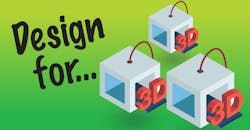DFAM: Design for Additive Manufacturing Arrives
A lot is happening in Design for Manufacturability (DFM) these days. The body of DFM knowledge originated in the early 1970s and has been growing steadily ever since. Hitachi, Westinghouse, and Stuart Pugh (Pugh Matrix) were early explorers. On the academic side, professors Geoffrey Boothroyd, Peter Dewhurst, Winston Knight, and a handful of others built-out initial approaches into methods that could be applied systematically to assembling products. They then laid out sets of methods for manufacturing components of different technologies. The Medal of Technology awarded by Bush 41 in 1991 for Boothroyd and Dewhurst’s work on Design for Manufacturing and Assembly (DFMA®) assured there was no looking back.
Trade-offs: To grasp the bigger picture, it is useful to start by thinking about how to optimize a design. The scope is far greater than just design for manufacturability or assembly; it is Design for X (DFX). Shouldn’t we also optimize designs for reliability, serviceability, environmental impact, recyclability, inspection, and cost, among a dozen more things? Engineers know when they optimize a design for any single variable, they make trade-offs that are usually unfavorable to the other variables. But manufacturing and assembly are good places to start design optimization thinking, as cost and reliability are both tightly tied to a product’s producibility. Inspection and serviceability are a bit different, as are some of the other DFX possibilities. For example, how many times have you heard your automotive service technician say, “if manufacturers would build cars so we could get at the things we need to fix, your bill would be lower.” Alas, there are always trade-offs when optimizing designs.
Design for X: We have now touched on Design for Manufacturing (DFM), Design for Assembly (DFA), Design for Reliability (DFR), Design for Serviceability (DFS), Design for Inspection (DFI), and Design for Cost (DFC). This seems like a lot, but we are just getting started. As industry was just getting its arms around these value-producing design techniques in the early 2000s, European landfills began filling up simultaneously as a global wave of environmental warming concern began. Resultant EU legislation led to mandatory requirements for certain products to meet environmental standards and be recyclable. This led to the birth of Design for Recyclability (DFR), Design for Disassembly (DFD), and Design for Environment (DFE). These new members of the DFX family began their own evolution 30 years after the inception of DFM.
New to DFX: Without exploring all the “ilities” categories and their techniques and methods, there is a new DFX emerging. This is not any run-of-the-mill thing either. 3D printing has been around since the late 1980s. 3D technology is soon to mature into a reliable manufacturing process for certain types and categories of metal, plastic, and composite products. When 3D enters the factory and starts displacing traditional discrete and job-shop final production processes, as well as changing intermediate process steps, it will need to be optimized just like other production processes.
DFAM: Additive Manufacturing (AM) will soon require a methodology for systematically designing products to optimize how they are produced using AM. Rapid prototyping and 3D printing are about validating design parameters and basic concepts of production. The production process adds a whole level of design detail. Initial Design for Additive Manufacturing (DFAM) work began about three years ago. Its Wikipedia page began in September 2016. Seminars are starting.
On the Horizon: Products of the future must be smart and connected. One must design for connectivity in the factory during manufacture to enable real-time process feedback and evaluation. And, design considerations for connectivity certainly extend to when the product is in the hands of the customer. Design for the IIoT and Design for the IoT each require their own approach. Specific techniques will evolve for effective ways to embed sensors, orient parts in assemblies to assure reliable connectivity, and to transmit data. These DFX approaches will require their own unique trade-offs. Purely optimizing manufacturability and cost likely will not optimize factory interactability nor revenue-producing internet connectivity.
About the Author
Bradford Goldense
Contributing Technical Expert
Bradford L. Goldense is founder and president of Goldense Group, Inc. [GGI] (www.goldensegroupinc.com), a consulting, market research, and education firm focused on business and technology management strategies and practices for product creation, development, and commercialization. He has been an adjunct faculty member of the graduate engineering school at Tufts University's Gordon Institute for 19 years. Goldense is a Certified New Product Development Professional [NPDP], a Certified Manufacturing Engineer [CMfgE], a Certified Computer Professional [CCP], and is Certified In Production & Inventory Management [CPIM]. He holds over 200 registered copyrights and is a recognized subject-matter expert, including appearances on PBS and CNBC. He has consulted to over 250 companies and over 750 manufacturing locations on four continents since founding GGI in 1986. Goldense holds an MBA in Accounting from the Cornell Johnson School and a BSCE from Brown University. For more information, please see Brad's LinkedIn profile or visit GGI's home page.

